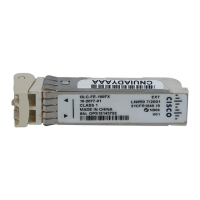Configure SFPs
Configure Interface Speed and Duplex Mode
Ethernet interfaces on the switch operate at 10, 100, or 1000 Mbps, or 10,000 Mbps and in either full- or
half-duplex mode. In full-duplex mode, two stations can send and receive traffic at the same time.
Normally, 10-Mbps ports operate in half-duplex mode, which means that stations can either receive or
send traffic.
You cannot configure speed on SFP module ports, but you can configure speed to not negotiate
(nonegotiate) if connected to a device that does not support autonegotiation. However, when a
1000BASE-T SFP module is in the SFP module port, you can configure speed as 10, 100, or 1000 Mbps,
or auto.
You cannot configure duplex mode on SFP module ports unless a 1000BASE-T SFP module or a
100BASE-FX MMF SFP module is in the port. All other SFP modules operate only in full-duplex mode.
z When a 1000BASE-T SFP module is in the SFP module port, you can configure duplex mode to
auto or full.
z When a 100BASE-FX SFP module is in the SFP module port, you can configure duplex mode to
half or full.
Note: Half-duplex mode is supported on Gigabit Ethernet interfaces. However, you cannot configure these
interfaces to operate in half-duplex mode.
In order to display the information about an optical transceiver installed, use this command: show hw-
module subslot slot/subslot transceiver port idprom.
Use Third Party SFP Modules
The use of third party SFP transceivers with Cisco devices is not supported by Cisco. Cisco-approved SFP
modules have a serial EEPROM that contains the module serial number, the vendor name and ID, a
unique security code, and cyclic redundancy check (CRC). When an SFP module is inserted in the switch,
the switch software reads the EEPROM to verify the serial number, vendor name and vendor ID, and
recomputes the security code and CRC. If the serial number, the vendor name or vendor ID, the security
code, or CRC is invalid, the software generates this security error message and places the interface in an
error-disabled state:
SYS-3-TRANSCEIVER_NOTAPPROVED:Transceiver on port [dec]/[dec] is not supported
Connect a SFP Module to a GBIC Module
The SFP and GBIC is just a connection between the actual laser and the chassis. You need to verify these
in order to connect a SFP module with a GBIC module:
z The type of fiber optic cable used: Single Mode or Multi Mode.
z The type of physical connection required: SC connector, ST connector, etc.
Troubleshoot SFPs
The Link Does Not Come Up in the Sup720 Module with Line Cards WS-X6724-SFP and WS-
X6748-SFP, Even After a Reboot
This issue is due to an Online Insertion and Removal (OIR) or a reboot that caused the port to move into
the disabled state. This problem most likely occurs in a Supervisor 720 (Sup720) that runs Catalyst OS
(CatOS) versions 8.4(2), 8.4(3) with line cards WS-X6724-SFP and WS-X6748-SFP.
If the port is not in the disabled state before a reboot or OIR, the port remains in operation after the reboot.
However, if the port is in diasbled state before or after a reboot, toggle the negotiation state of the port
before the remote end is connected. Complete these steps in order to to
le the ne
otiation of the port:
1000BASE-
ZX
1550 SMF
Approximately 70 km,
which depends on
link loss
1000BASE-
BX-D
1310 SMF 10 km (32,8210 ft)
1000BASE-
BX-U
1490 SMF 10 km (32,8210 ft)

